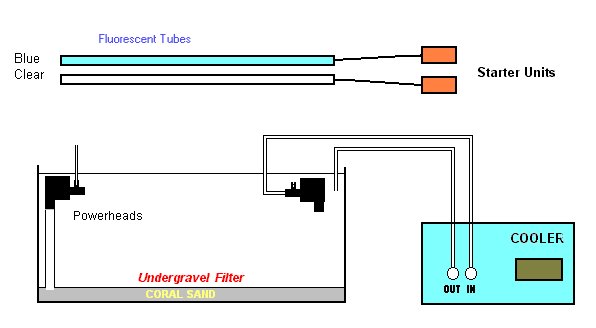LIGHTING IN THE MARINE AQUARIUM
and for the
Photographer
by Andy Horton
There are several types of lighting that
can be used to illuminate the marine aquarium. They should be purchased from a
special aquarium retailer:
Flourescent.
Flourescent Blue Lights.
Metal Halides (for large
invertebrate aquaria)
Mercury Vapour (for large
invertebrate aquaria)

For the smaller fish-only marine aquarium I suggest the combination of a clear daylight flourescent strip, plus a blue one.
However, tropical marine invertebrate aquaria, and temperate aquaria with anemones containing symbiotic algae, require special high intensity lighting.
INTENSITY OF LIGHT
Readings taken with a light meter
on the ground (average grey).
| EXPOSURE VALUE | LUX READING | CAMERA SHUTTER SPEED FILM ASA 100 APERTURE f.16 |
| 15 Bright Sunlight,
Mediterranean, California, Tropical |
175000 | 1/125th second |
| 14 Weak Sun, Tropical | 88000 | 1/60th second |
| 13 Sunny Day, Britain | 44000 | 1/30th second |
| 12 Cloudy Day | 22000 | 1/15th second |
| 11 Tropical Invertebrate Aquarium with Corals (minimum) |
11000 | 1/8th second |
| 10 Anemones without zooxanthellae | 5500 | 1/4 second |
| 9 Deeper living Invertebrates | 2800 | 1/2 second |
| 8 Tropical Marine Fish | 1400 | 1 second |
| 7 Light suitable for reading | 700 | 2 seconds |
| 6 Interior of Building (brightly lit) | 350 | 3 seconds |
| 5 Domestic Interior (average) | 175 | 4 seconds |
| 4 | 88 | 8 seconds |
| 3 | 44 | 16 seconds |
| 2 | 22 | 30 seconds |
| 1 | 11 | 1 minute |
COLOUR TEMPERATURE (COLOUR SPECTRUM)
Natural daylight has a colour temperature of about 5500° Kelvin. The higher the ° Kelvin, the bluer the light. Ordinary flourescent bulbs are likely to have a colour temperature of about 3000° K and impart an orange tinge which is aesthetically undesirable. Choose strips with colour temperature of 6500° K designed as natural daylight lamps and/or flourescent strips imparting a strong blue light at a colour temperature of 10000° K.
Photography in the
Aquarium (Link)
Nature Photography (including LUX readings conversion)